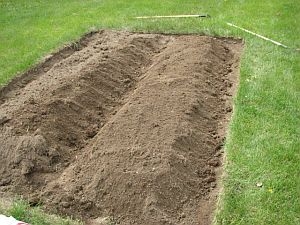 (HOST) Gardening guy Henry Homeyer has been experimenting with small-scale gardens designed to save both money and time – set in the middle of the lawn – so preparing the soil is a key to success.
(HOST) Gardening guy Henry Homeyer has been experimenting with small-scale gardens designed to save both money and time – set in the middle of the lawn – so preparing the soil is a key to success.
(HOMEYER) One sure way to cut down on your food bill is to start a garden – even if it’s just a small one. And now is a good time to do some planning. Last summer I helped a few friends start small vegetable gardens. We had great luck with them, so I’m hoping to encourage others to do the same. We grew a little of everything – from artichokes to zucchini. Each garden was just 12 feet long, 8 to 10 feet wide, and each was plunked down in full sun – in middle of the lawn.
One of the keys to a good garden is having it in full sun – which is why starting a garden in the middle of the lawn makes sense, not tucking it in behind the garage or snuggling it up to a line of trees whose roots would compete with our veggies for minerals and water.
Good soil is important, of course, but any soil can be made productive by adding enough composted cow manure. And most of all, consistency is important. If you spend 15 minutes a day, you can keep your garden weed-free – so long as you don’t try to make a garden the size your Grandma probably did.
For my little gardens-in-the-lawn, I first dug up the sod and used it to start a compost pile.
I sent off a soil sample for testing, and was not surprised to learn that the soil was low in organic matter and essential minerals; it was more acidic than it should be for growing vegetables. No problem. I added 10 bags of composted cow manure. I mixed the compost into the soil along with 8 cups of bagged organic fertilizer and some limestone. Limestone sweetens the soil, making it less acidic. I raked the loose soil into 2 raised beds, each about 30 inches wide and 6 inches taller than the walkway up the middle of the plot.
Starting a small garden, if you’ve never done it before, does involve some investment. You need to buy a shovel, a garden rake, a weeding tool and a watering can or hose. You need to buy a bag of organic fertilizer and some compost if you don’t make your own. And of course you need to buy some seeds or starter plants. But after the first year’s investment, having a garden is a big plus for your budget.
One of these gardens was for a friend in Cornish Flat who loved the veggies. She said the flavors were so much better than produce from the store. We grew so much food that she had to share it with family and friends. She saw how little work is involved, and said that maybe next year she’ll do it all by herself.
So if you want to save some money, start planning a garden. Read those seed catalogs or go on line to see what’s available. Winter is the time for planning, and I’m already thinking about the red, ripe tomatoes I’ll grow next summer.